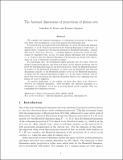The Assouad dimensions of projections of planar sets
Abstract
We consider the Assouad dimensions of orthogonal projections of planar sets onto lines. Our investigation covers both general and self-similar sets. For general sets, the main result is the following: if a set in the plane has Assouad dimension s ∈ [0, 2], then the projections have Assouad dimension at least min{1, s} almost surely. Compared to the famous analogue for Hausdorff dimension – namely Marstrand’s Projection Theorem – a striking difference is that the words ‘at least’cannot be dispensed with: in fact, for many planar self-similar sets of dimension s < 1, we prove that the Assouad dimension of projections can attain both values sand 1 for a set of directions of positive measure. For self-similar sets, our investigation splits naturally into two cases: when the group of rotations is discrete, and when it is dense. In the ‘discrete rotations’ case we prove the following dichotomy for any given projection: either the Hausdorff measure is positive in the Hausdorff dimension, in which case the Hausdorff and Assouad dimensions coincide; or the Hausdorff measure is zero in the Hausdorff dimension,in which case the Assouad dimension is equal to 1. In the ‘dense rotations’ case we prove that every projection has Assouad dimension equal to one, assuming that the planar set is not a singleton. As another application of our results, we show that there is no Falconer’s Theorem for Assouad dimension. More precisely, the Assouad dimension of a self-similar (or self-affine) set is not in general almost surely constant when one randomises the translation vectors.
Citation
Fraser , J M & Orponen , T 2017 , ' The Assouad dimensions of projections of planar sets ' , Proceedings of the London Mathematical Society , vol. 114 , no. 2 , pp. 374-398 . https://doi.org/10.1112/plms.12012
Publication
Proceedings of the London Mathematical Society
Status
Peer reviewed
ISSN
0024-6115Type
Journal article
Description
The first named author is supported by a Leverhulme Trust Research Fellowship and the second named author is supported by the Academy of Finland through the grant Restricted families of projections and connections to Kakeya type problems, grant number 274512.Collections
Items in the St Andrews Research Repository are protected by copyright, with all rights reserved, unless otherwise indicated.

